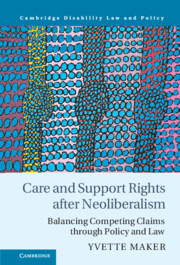Book contents
- Care and Support Rights after Neoliberalism
- Cambridge Disability Law and Policy Series
- Care and Support Rights after Neoliberalism
- Copyright page
- Contents
- Table
- Foreword
- Acknowledgments
- Abbreviations
- Introduction
- Part I Care Policy Tensions
- Part II Balancing Competing Claims through Rights-Based Policy and Law
- Part III Care and Support Policy Tensions in Two Liberal Welfare States
- 6 Income Support for Carers of Children with Disabilities in Australia
- 7 Care, Disability and Gender Equality in Australian Carers’ Income Support
- 8 Incorporating Multiple Options and Perspectives
- 9 Care and Support for Adults in England
- 10 Care, Disability and Gender Equality in English Care and Support Policy
- 11 Maximizing Options and Opportunities
- Conclusion
- Index
- Other Books in the Series
7 - Care, Disability and Gender Equality in Australian Carers’ Income Support
Narrow Choices and Unheard Voices
from Part III - Care and Support Policy Tensions in Two Liberal Welfare States
Published online by Cambridge University Press: 21 April 2022
- Care and Support Rights after Neoliberalism
- Cambridge Disability Law and Policy Series
- Care and Support Rights after Neoliberalism
- Copyright page
- Contents
- Table
- Foreword
- Acknowledgments
- Abbreviations
- Introduction
- Part I Care Policy Tensions
- Part II Balancing Competing Claims through Rights-Based Policy and Law
- Part III Care and Support Policy Tensions in Two Liberal Welfare States
- 6 Income Support for Carers of Children with Disabilities in Australia
- 7 Care, Disability and Gender Equality in Australian Carers’ Income Support
- 8 Incorporating Multiple Options and Perspectives
- 9 Care and Support for Adults in England
- 10 Care, Disability and Gender Equality in English Care and Support Policy
- 11 Maximizing Options and Opportunities
- Conclusion
- Index
- Other Books in the Series
Summary
This chapter examines how Australia’s Carer Payment (child) policy treats the activities and constituencies of interest in this book and highlights the discourses and norms of care, disability and paid work that underpin this treatment. The policy has limited benefits and many shortcomings for both carers and children with disabilities. Its availability to some carers with the most ‘intense’ care loads does place economic value on the traditionally undervalued activity of care but reinforces the full-time caring role and provides inadequate support for alternatives. Consequently, many of the ‘burdens’ identified by carers are ignored and perhaps exacerbated. Carer Payment (child) treats unpaid care and paid work as largely incompatible activities and does not problematize the unequal gender division of labor or address its consequences for women. Carers’ eligibility assessments are focused on the individual, medical needs of the child, and carers are assumed to be the best people to meet those needs. As a result, the views and preferences of children with disabilities are not sought or expressed, and their broader rights are not considered.
Keywords
- Type
- Chapter
- Information
- Care and Support Rights After NeoliberalismBalancing Competing Claims Through Policy and Law, pp. 150 - 170Publisher: Cambridge University PressPrint publication year: 2022



